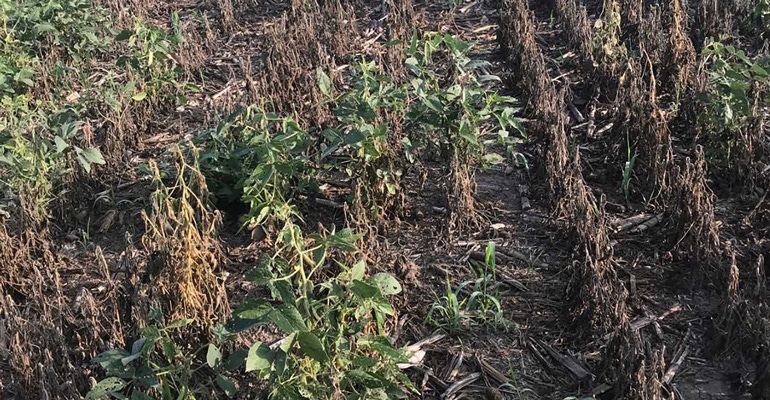
Soybean gall midge has been getting a lot of attention in Nebraska since it was first confirmed in the eastern part of the state during the 2018 growing season — identifiable by orange larva feeding on soybean stems, eventually killing soybean plants.
As the 2019 season has progressed, soybean gall midge has again been identified — in Cass and Saunders counties in June.
"This is the first time we've placed cages of this insect in the spring," says Justin McMechan, Nebraska Extension crop protection and cropping systems specialist. “The number of adult soybean gall midge we collect now doesn't tell us how much damage we're going to get this year. That's the hardest part. It's been damaging fields since 2009 on local, isolated incidents. In 2018, it was all over the eastern part of the state, however."
With the heavy presence of gall midge last year and its reappearance this year, McMechan notes researchers have made headway — first identifying it as an entirely new species, placing traps in fields this spring, and now gaining an understanding of the midge's spring emergence patterns.
And understanding its emergence patterns will ultimately drive decisions for controlling the midge, particularly with insecticide. Once female midges emerge, they immediately seek a host plant to lay eggs on. Based on similar species, we assume soybean gall midge will lay eggs on the outside of the plant, larva hatch, and then burrow into the plant itself, eventually killing it. This process may take as long as three weeks — although the exact length of the infestation period isn't yet known for certain.
"It's a complicated thing when we manage something we don't know a lot about," says McMechan. "Last year, I couldn't get successful infestation in the greenhouse on plants at V3. Some growers spraying in June this year may have been at the V1 or V2 stage. If midges hadn't yet infested those plants, growers would assume the insecticide did a great job. We should all be very cautious about what stages we can control soybean gall midge at until we learn more."
He recommends applying insecticide in strips to determine whether an application makes sense at certain growth stages. While there are no chemistries currently labeled for gall midge, it's probably best to apply an insecticide with long residual activity, McMechan says. "In our southern Cass County site, in our fifth day of collecting adults, the numbers were still climbing. Hopefully that declines, but my fear is it keeps going for 10 more days."
Spring tillage may play a role in increasing gall midge populations. McMechan notes that so far this year they have had adult emergence from tilled locations within fields. "In some cases, tilled plots were the first areas to see emergence,” he explains. “It’s possible that the tillage leaves some adults closer to the soil surface and warms them up, and they emerge sooner.”
McMechan is using time-lapse cameras to visually document infestations to determine how long they typically last, which should provide some answers on insecticide efficacy.
More information will be available later this year, but McMechan notes based on last year's observations, it appears the midges infested plants around V3 and ceased growth around V5. That was in early June 2018. By late June, plants were dying.
"Just because we have soybean gall midge emerging does not mean we're going to see a repeat of 2018,” McMechan says. “It doesn't imply fields will get leveled. All we know is it's emerging, and it doesn't appear we have an opportunity to control them once they're in the plant. The fields that have issues, or are adjacent to field with issues, those are the ones we'd suggest taking action this year. If there are no issues in or adjacent to the field, taking action probably wouldn't make sense."
About the Author(s)
You May Also Like






